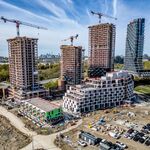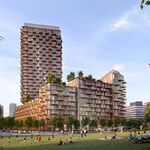You are using an out of date browser. It may not display this or other websites correctly.
You should upgrade or use an alternative browser.
You should upgrade or use an alternative browser.
New York Magazine: BRT is the future for NYC?
- Thread starter kettal
- Start date
threnody
Active Member
Thanks for posting this. It's very interesting. Unfortunately Toronto's narrow streets make this sort of thing much more of a challenge to implement. I am hopeful that POP all-door level boarding with the new streetcars will speed things up though.
kEiThZ
Superstar
Thanks for posting this. It's very interesting. Unfortunately Toronto's narrow streets make this sort of thing much more of a challenge to implement. I am hopeful that POP all-door level boarding with the new streetcars will speed things up though.
Not really. If we have room in the suburbs to put in LRT, then there's room for BRT. The corridors where you can't put LRT is also where BRT is not feasible unless you are willing to give up road space.
kettal
Banned
TTC already has one of the best bus networks in the world. It needs to adopt system-wide BRT practices such as all-door loading, signal priority, and jump-ahead lanes at intersections.
EnviroTO
Senior Member
Not really. If we have room in the suburbs to put in LRT, then there's room for BRT. The corridors where you can't put LRT is also where BRT is not feasible unless you are willing to give up road space.
Not really. To build BRT you need more space, not by a lot, since the bus is not on a fixed guideway and therefore needs room to handle the fact that buses will not be perfectly aligned in the ROW. All bus drivers deviate from the centre of the ROW as they drive so allowance needs to be built in for that. Also buses are slightly wider than the Toronto streetcars to begin with, almost as wide as the LRT vehicles.
CDL.TO
Moderator
TTC already has one of the best bus networks in the world. It needs to adopt system-wide BRT practices such as all-door loading, signal priority, and jump-ahead lanes at intersections.
That's right. In a lot of places they would call what we have now on the 190, 191, 192, 196, and the 39E "BRT". A lot of it is marketing. Adding in all-door loading, more signal priority (most of these routes already have some), and queue-jump lanes would make these routes extremely successful.
Last edited:
reaperexpress
Senior Member
That's right. In a lot of places they would call what we have now on the 190, 191, 192, 196, and the 39E "BRT". A lot of it is marketing. Adding in all-door loading, more signal priority (most of these routes already have some), and queue-jump lanes would make these routes extremely successful.
Route 196 is already BRT by any definition. The main branch (196A) travels almost exclusively in bus lanes and busways. Adding or extending right turn lanes is a good idea on all bus routes, not just expresses.
One huge improvement that could happen easily is to increase policing on the HOV and bus lanes. I was just driving on Eglinton, and I saw 4 buses stuck in car traffic IN A BUS LANE!
The article mentions putting cameras on buses to catch violators, but since cars are allowed to enter curb bus lanes to turn right, they could challenge the ticket, saying they were going to turn right. In addition to these cameras, I would suggest putting road-side cameras at locations where cars have no reason to be. For example, on Dufferin/Allen Road, cameras could automatically ticket any car northbound at Finch or Rimrock, and southbound at Kennard. On Eglinton there are a couple places: eastbound between McRoberts and Harvie, and westbound at Croham.
Last edited:
kEiThZ
Superstar
Not really. To build BRT you need more space, not by a lot, since the bus is not on a fixed guideway and therefore needs room to handle the fact that buses will not be perfectly aligned in the ROW. All bus drivers deviate from the centre of the ROW as they drive so allowance needs to be built in for that. Also buses are slightly wider than the Toronto streetcars to begin with, almost as wide as the LRT vehicles.
That difference is a handful of inches for each lane. Hardly the determining factor.
afransen
Senior Member
That's right. In a lot of places they would call what we have now on the 190, 191, 192, 196, and the 39E "BRT". A lot of it is marketing. Adding in all-door loading, more signal priority (most of these routes already have some), and queue-jump lanes would make these routes extremely successful.
Unfortunately, many of those routes have awful fare recovery, on the order of 25 - 40%. If that's what BRT can operate at, perhaps it's not a very good solution after all.
Not really. To build BRT you need more space, not by a lot, since the bus is not on a fixed guideway and therefore needs room to handle the fact that buses will not be perfectly aligned in the ROW. All bus drivers deviate from the centre of the ROW as they drive so allowance needs to be built in for that. Also buses are slightly wider than the Toronto streetcars to begin with, almost as wide as the LRT vehicles.
Unless you run it with curbside bus lanes. In which case, the station is part of the sidewalk, not in the median as it would be with LRT. It works out to being a matter of a foot or two between the two.
ShonTron
Moderator
Member Bio
- Joined
- Apr 24, 2007
- Messages
- 12,457
- Reaction score
- 9,232
- Location
- Ward 13 - Toronto Centre
Unfortunately, many of those routes have awful fare recovery, on the order of 25 - 40%. If that's what BRT can operate at, perhaps it's not a very good solution after all.
The 191, 192 and 196 have low fare recovery for two reasons:
1. Low to nil turnover. Not so much because they are express, but because they have looooong stopless stretches, especially 191 and 192 where they run on the 427, and passengers all almost all going point-to-point at the opposite ends, same with the 196.
The 190 has lots of passenger turnover, of whom relatively few are going Don Mills to STC or vice-versa. It's bundled into the 85 for stat calculation, though, but the TTC has been steadily improving that route since the Sheppard Subway opened.
2. With the 191, 192 and 196, just about all the customers outbound board at the fare-paid subway station. The TTC's stats aren't great for determining fare recovery anyway, and without money and tickets/tokens in the box in one direction, really skews it.
I would strongly suspect that regular BRT route would show a healthier fare recovery.
Last edited:




